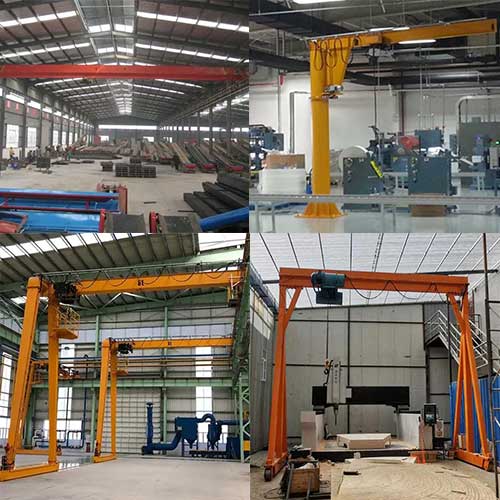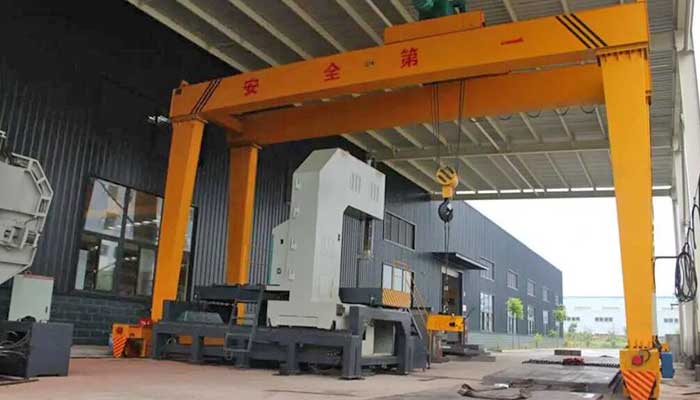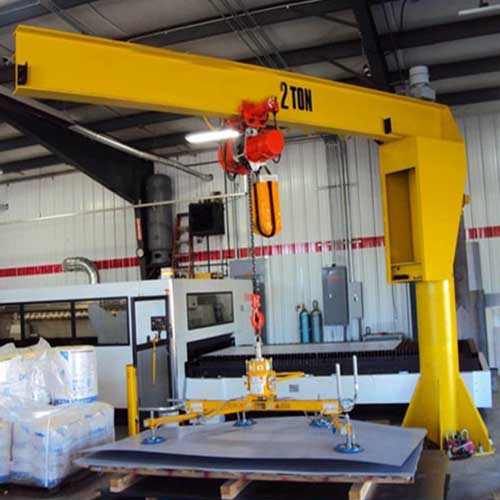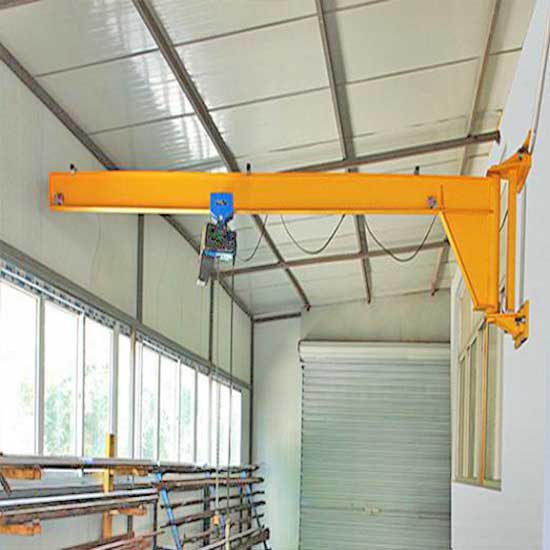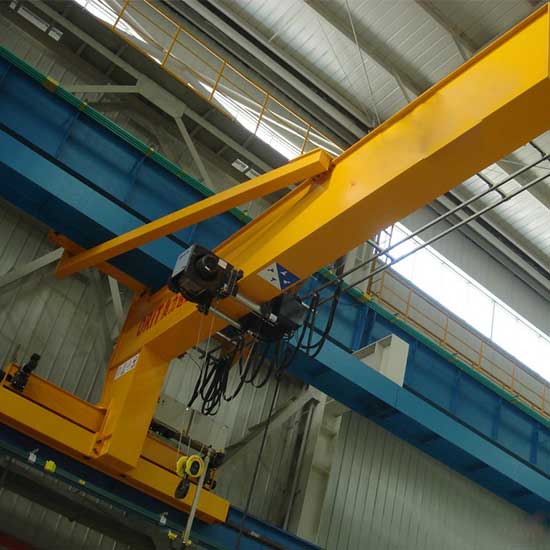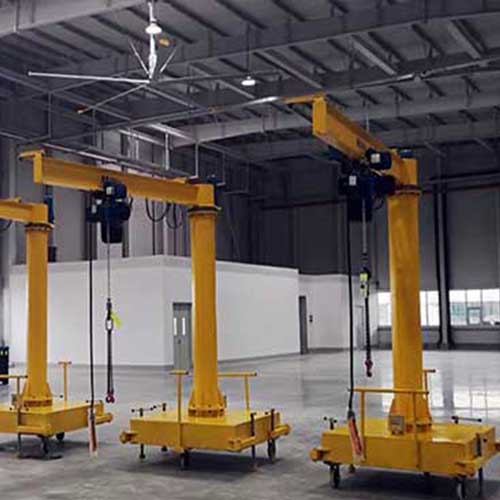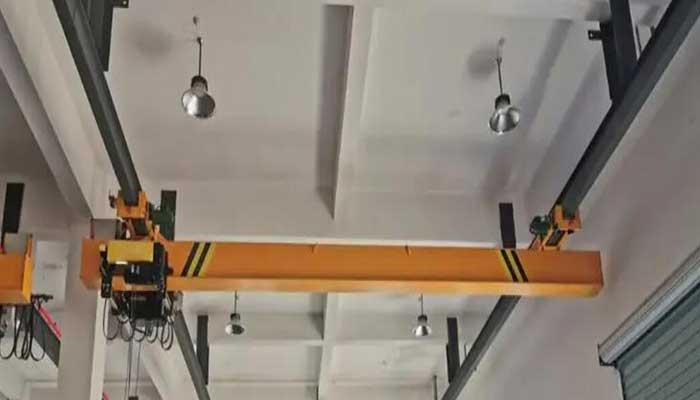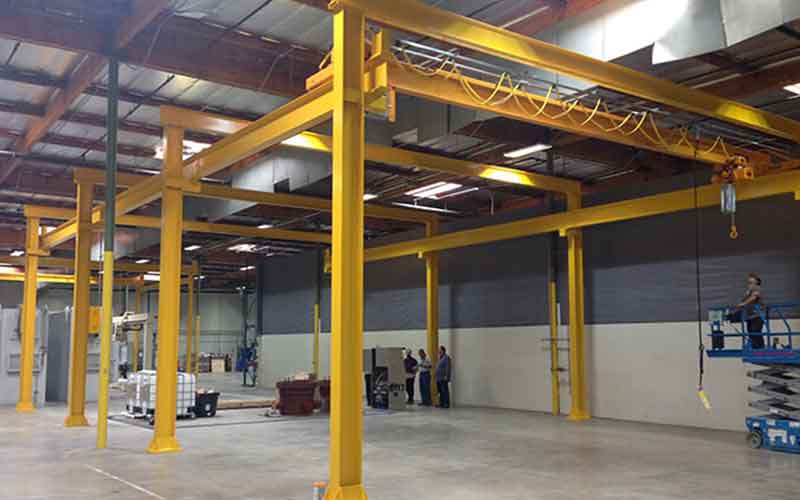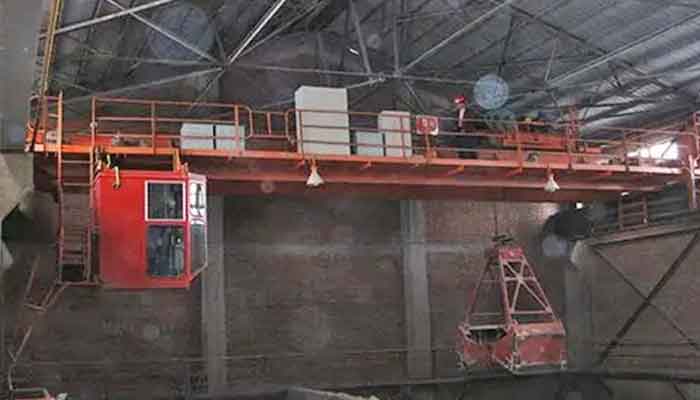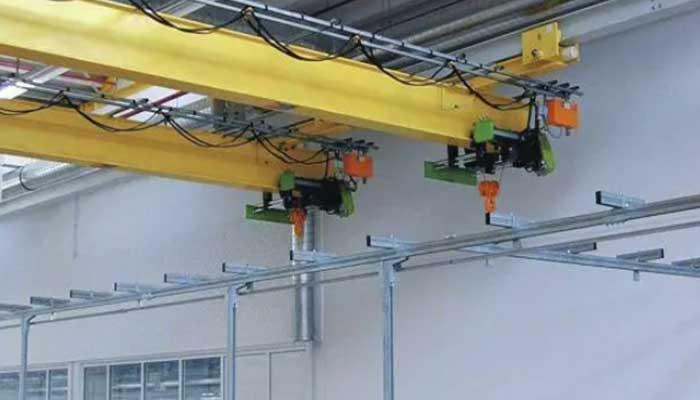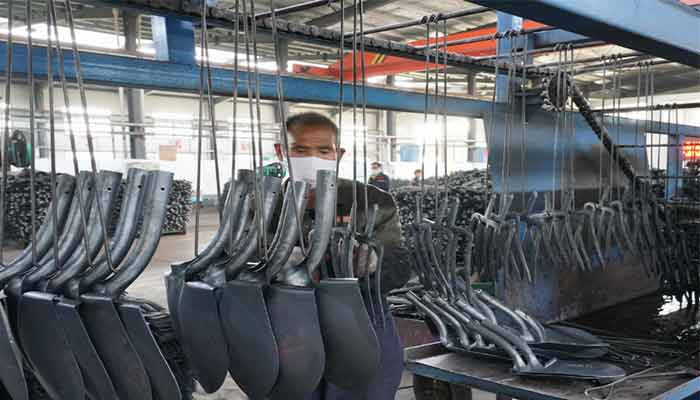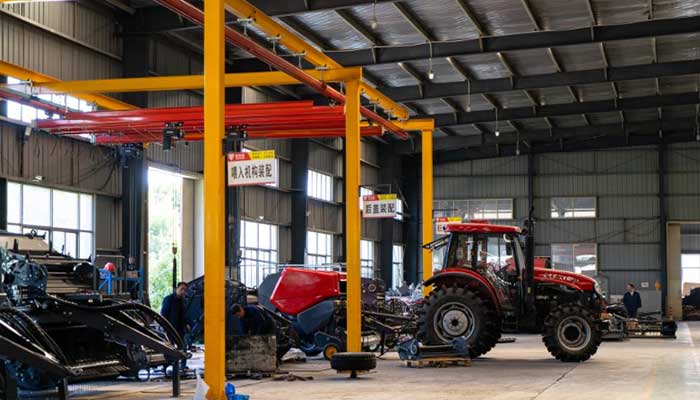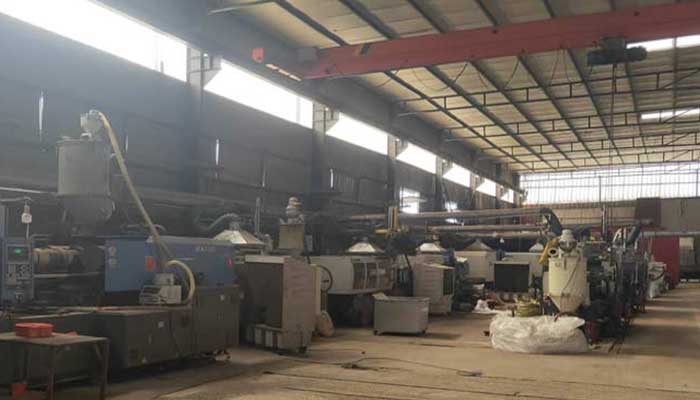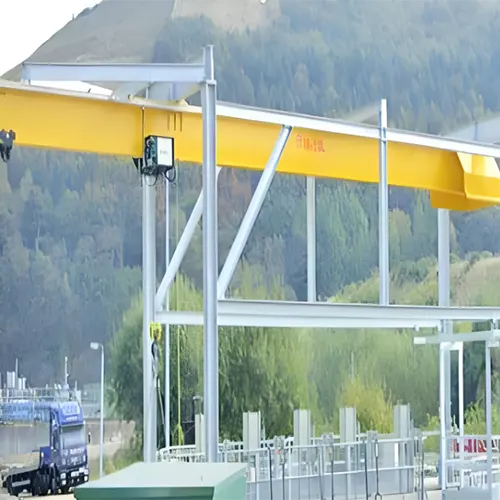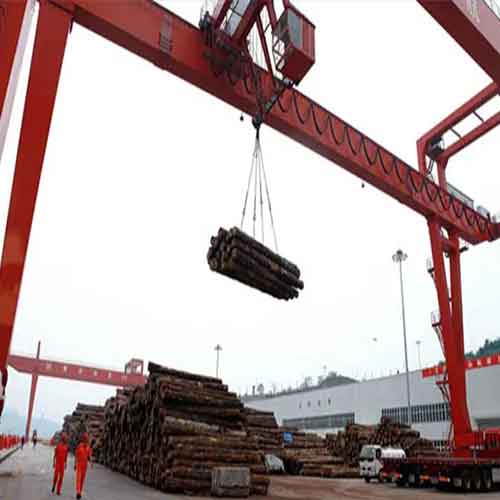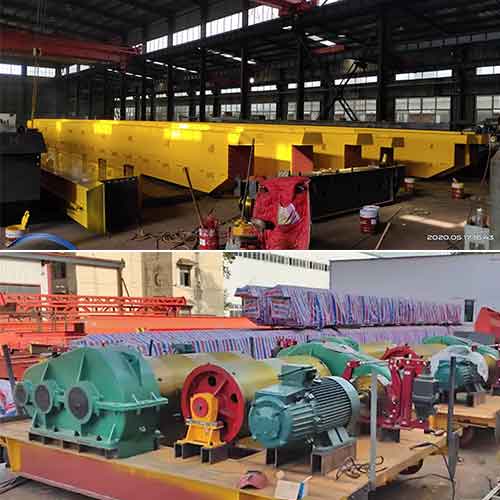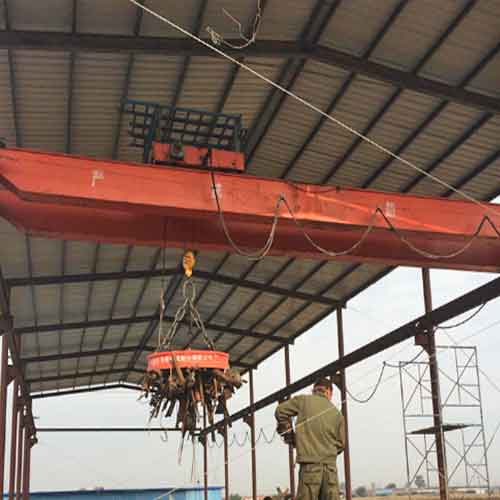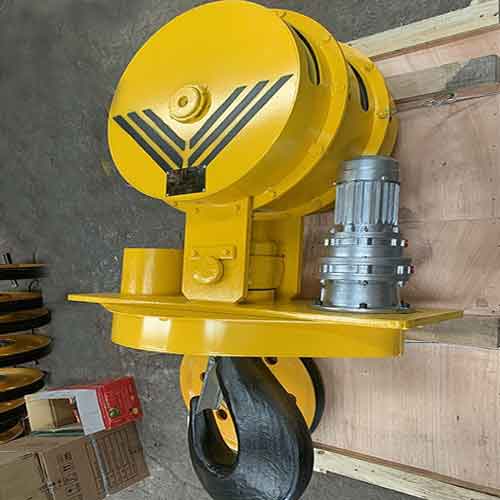Indoor Crane System: Types of Indoor Crane Systems to Improve Efficiency
Indoor crane for sale. All types of indoor crane system to improve your workflow efficiency. How overhead crane systems optimizes industrial workflows. Chick.
Category: Indoor Crane
Your Trusted Indoor Crane System Manufacturer & Supplier
Indoor Crane System: How Indoor Crane System Improve Efficiency
All types of indoor crane system to improve your workflow efficiency
Indoor crane for sale. All types of indoor crane system to improve your workflow efficiency. How overhead crane systems optimizes industrial workflows. Chick.
The Impact of Indoor Crane Systems on Workflow Efficiency
In the bustling world of industry, where every moment counts and every movement of materials is a pivotal piece of the puzzle, the role of material handling cannot be understated. Whether it's manufacturing, construction, warehousing, or maintenance, efficient material handling is the backbone of operational success. As industries evolve, so do the tools and technologies they employ, and one such innovation that has been revolutionizing the scene is indoor crane systems. These systems, comprising various types of cranes, have become integral to optimizing workflow efficiency in a wide range of indoor applications.
Material handling has come a long way, tracing a journey from the sheer brute force of manual labor to the precision and efficiency of modern industrial environments. The early days of material handling were marked by backbreaking labor, with workers physically transporting goods, often resulting in inefficiency, delays, and, regrettably, injury.
As industries recognized the need for efficiency and productivity, they began embracing mechanical assistance in the form of pulleys, conveyors, and forklifts. These tools significantly improved the movement of materials, reducing the strain on labor and increasing throughput.
In the 21st century, the evolution of material handling took a giant leap with the advent of indoor crane systems. These systems combine various types of cranes to optimize material handling in indoor environments. The primary aim is to enhance workflow efficiency, reduce downtime, and improve overall productivity.
Types of Indoor Crane Systems
To truly understand the impact of indoor crane systems on workflow efficiency, it's crucial to explore the various types of indoor crane systems, their components, and how each type contributes to the optimization of material handling processes.
Gantry Crane Systems
Components: Gantry crane systems consist of a horizontal bridge supported by two legs on wheels or casters. They are equipped with a hoist to lift and lower loads.
Contribution to Workflow Efficiency:
- Mobility: Gantry cranes are highly mobile and can be moved along tracks or wheels, allowing for the efficient transport of heavy materials within indoor facilities.
- Versatile Load Capacity: Gantry cranes come in various load capacity options, catering to a wide range of material handling needs.
- Cost-Effectiveness: They offer a cost-effective solution for handling materials, making them suitable for small to medium-sized indoor operations.
Types of indoor gantry crane systems
Indoor gantry crane systems are versatile material handling solutions that find applications in a wide range of industries. There are several types of indoor gantry crane systems, each designed to meet specific material handling needs. Here are some common types of indoor gantry crane systems:
- Portable Gantry Crane: Portable gantry cranes are mounted on wheels or casters, providing high mobility. They are ideal for facilities where you need to move the crane to different workstations or locations. Their portability ensures that you can efficiently handle materials wherever they are needed.
Adjustable Height Gantry Crane: These gantry cranes are designed with adjustable height features, allowing you to lift loads to different heights within your facility. This adaptability is particularly useful when handling loads of varying sizes or working in areas with limited vertical space. - Adjustable Width Gantry Crane: Some gantry cranes have adjustable width features, allowing you to change the span between the legs. This adjustability is valuable when you need to lift loads of different sizes within the same facility.
- Aluminum Gantry Crane: Aluminum gantry cranes are known for their lightweight yet durable construction. They are corrosion-resistant and suitable for both indoor and outdoor use. These cranes are often used in clean room environments and facilities with specific cleanliness requirements.
- Fixed Gantry Crane: Unlike portable gantry cranes, fixed gantry cranes are permanently installed in a specific location within your facility. These cranes are often used for lifting and moving heavy loads in a dedicated area where mobility is not a requirement.
- Single Girder Gantry Crane: Single girder gantry cranes feature one horizontal beam (girder) that supports the hoist and trolley. They are suitable for lighter loads and applications where high maneuverability is necessary.
- Double Girder Gantry Crane: Double girder gantry cranes have two horizontal beams (girders) that provide increased stability and lifting capacity. They are commonly used in heavy-duty applications and can handle larger loads.
- Rail-Mounted Gantry Crane (RMG): RMGs are specialized gantry cranes used in container handling at ports and intermodal rail yards. They run on a rail system and are designed for efficient and precise container stacking and retrieval.
- Truss Gantry Crane: Truss gantry cranes feature a truss-like frame structure that provides additional stability and strength. These cranes are ideal for outdoor or indoor applications that require enhanced structural support.
- Workstation Gantry Crane: Workstation gantry cranes are designed to handle materials at specific workstations or assembly lines. They provide precise load positioning, making them ideal for improving workflow efficiency at individual work areas.
Here's a comparison of different types of indoor overhead crane systems in terms of features, benefits, and applications, presented in tabular form:
| Type of Overhead Crane System | Features | Benefits | Applications |
|---|---|---|---|
| Bridge Crane | - Travels on elevated runways | - High load capacity | - Large manufacturing facilities |
| - Wide coverage | - Efficient material movement | - Steel production | |
| Single Girder Overhead Crane | - Single horizontal beam (girder) | - Light to moderate lifting capacity | - Smaller manufacturing operations |
| - Suitable for smaller indoor spaces | - Cost-effective | - Maintenance facilities | |
| - Versatile lifting and movement | - Space-efficient | - Assembly lines | |
| Double Girder Overhead Crane | - Two horizontal beams (girders) | - High lifting capacity | - Large manufacturing facilities |
| - Increased stability | - Efficient handling of heavy loads | - Warehouses | |
| - Suitable for heavy-duty applications | - Wide coverage | - Industrial plants | |
| Top Running Overhead Crane | - Runs on rails on the building's top | - High lifting capacity | - Heavy manufacturing |
| - Requires sufficient headroom | - Wide coverage | - Large warehouses | |
| - Versatile lifting and movement | - Efficient use of overhead space | - Automotive manufacturing | |
| Under Running Overhead Crane | - Runs on rails beneath the ceiling | - Space-saving solution | - Workstations and assembly lines |
| - Suitable for limited headroom | - Precise load positioning | - Machining operations | |
| - Versatile lifting and movement | - Reduced interference with overhead structures | - Light manufacturing | |
| - Versatile lifting and movement | - Handling of heavy machinery and equipment | - Aerospace manufacturing | |
| Monorail Crane | - Single rail for linear material movement | - Continuous and efficient handling | - Assembly lines |
| - Hoist and trolley are suspended | - Space-saving solution | - Machining operations | |
| - Designed for fixed-path transport | - Precise and controlled movement | - Automotive manufacturing | |
| Workstation Crane | - Smaller overhead crane for workstations | - Precise material handling | - Individual workstations |
| - Designed for specific work areas | - Improved workflow efficiency | - Assembly lines | |
| - Enhances accuracy and productivity | - Reduced downtime | - Machining operations | |
| Aluminum Overhead Crane | - Lightweight yet durable construction | - Corrosion-resistant | - Clean room environments |
| - Suitable for both indoor and outdoor use | - Space-saving solution | - Facilities with cleanliness requirements | |
| - High corrosion resistance | - Low maintenance costs | - Warehouses | |
| Customized Overhead Crane | - Tailored to meet specific requirements | - Addresses unique material handling needs | - Unique and specialized material handling requirements |
This comparison provides an overview of the features, benefits, and typical applications of different types of indoor overhead crane systems, helping businesses choose the most suitable crane for their material handling needs.
The type of indoor gantry crane system you choose will depend on the specific requirements of your material handling tasks, including load capacity, space constraints, and mobility needs. Whether you need a portable solution for flexibility or a heavy-duty crane for high-capacity lifting, there is a gantry crane system designed to meet your unique indoor material handling needs.
Jib Crane Systems
Components: Jib crane systems are typically fixed to a vertical post or wall and consist of a horizontal or articulating arm with a hoist.
Contribution to Workflow Efficiency:
- Precise Load Positioning: Jib cranes provide precise load positioning, making them ideal for workstations and assembly lines.
- Space-Efficiency: They are space-efficient, as they don't require extensive floor space and can be installed in areas with height restrictions.
- Cost-Effectiveness: Jib cranes are a cost-effective solution for optimizing material handling at specific points within indoor facilities.
Types of indoor jib crane systems
Indoor jib crane systems are versatile material handling solutions used in a variety of industrial and manufacturing settings. These systems come in several types, each designed to meet specific material handling needs. Here are some common types of indoor jib crane systems:
- Free-Standing Jib Crane: A free-standing jib crane is a self-supporting structure that does not require attachment to a building's support columns or structure. It is anchored to the floor and provides 360-degree rotation, making it suitable for applications where loads need to be moved in all directions within a designated area.
- Wall-Mounted Jib Crane: Wall-mounted jib cranes are attached to the wall or a vertical support structure, providing a fixed point for lifting and moving loads. They offer 180-degree rotation and are commonly used in workspaces with limited floor space.
- Articulating Jib Crane: Articulating jib cranes, also known as knuckle jib cranes, have a pivoting arm with multiple joints that allow for precise load positioning. They offer a high degree of flexibility and are ideal for tasks that require precise load manipulation.
- Telescoping Jib Crane: Telescoping jib cranes feature an extendable arm that can reach varying lengths. This type of jib crane is suitable for handling loads at different distances from the crane's pivot point.
- Workstation Jib Crane: Workstation jib cranes are designed to handle materials at specific workstations or assembly lines. They provide precise load positioning, making them ideal for improving workflow efficiency at individual work areas.
- Column-Mounted Jib Crane: Column-mounted jib cranes are installed on a vertical support column within a facility. They provide efficient material handling in a designated area and can offer 360-degree rotation, depending on their design.
- Cantilever Jib Crane: Cantilever jib cranes feature a horizontal arm that is unsupported at one end. They are designed for applications where the load needs to be lifted over obstacles or into hard-to-reach areas.
- Foundation-Mounted Jib Crane: Foundation-mounted jib cranes are attached to a dedicated foundation, ensuring stability and high load capacity. These cranes are often used in heavy-duty applications.
The choice of indoor jib crane system depends on specific requirements, including load capacity, space constraints, and the need for precise load positioning. Whether you need a versatile free-standing jib crane, a space-saving wall-mounted jib crane, or a highly flexible articulating jib crane, there is a type of indoor jib crane system designed to meet your unique material handling needs.
Here's a comparison of different types of indoor jib crane systems in terms of features, benefits, and applications, presented in tabular form:
| Type of Jib Crane System | Features | Benefits | Applications |
|---|---|---|---|
| Free-Standing Jib Crane | - Self-supporting structure | - 360-degree rotation | - Work areas requiring versatile load movement |
| - Anchored to the floor | - Efficient material handling | - Warehouses, manufacturing facilities | |
| - 360-degree rotation | - Reduced floor space requirements | - Assembly lines, loading docks | |
| Wall-Mounted Jib Crane | - Attached to a wall or vertical support structure | - 180-degree rotation | - Workspaces with limited floor space |
| - 180-degree rotation | - Precise load positioning | - Machine shops, small workshops | |
| - Efficient use of space | - Reduced interference with floor activities | - Material handling at specific points | |
| Articulating Jib Crane | - Pivoting arm with multiple joints | - Highly flexible for load positioning | - Assembly lines, machining operations |
| - Precise load positioning | - Optimized workflow efficiency | - Tasks requiring precision handling | |
| - High level of flexibility | - Reduced operator fatigue | - Small-scale manufacturing, assembly areas | |
| Telescoping Jib Crane | - Extendable arm for varying reach | - Versatility in load handling | - Facilities with varying load distances |
| - Precise load positioning | - Efficient use of overhead space | - Machining operations, assembly lines | |
| - Reduced operator fatigue | - Optimized material flow | - Workstations with varying load distances | |
| Workstation Jib Crane | - Designed for specific workstations | - Enhanced accuracy and productivity | - Individual workstations, assembly lines, production |
| - Precise load positioning | - Reduced downtime | - Workstations, machining operations, small-scale mfg. |
Overhead Crane Systems
Components: Overhead crane systems are suspended from the ceiling and move along tracks attached to the ceiling structure. They feature a hoist for lifting and lowering heavy loads.
Contribution to Workflow Efficiency:
- High Lifting Capacity: Overhead cranes are renowned for their high lifting capacity, making them suitable for heavy industries and large-scale manufacturing.
- Full Coverage: They provide full coverage of the workspace, allowing for efficient material handling over a wide area.
- Durability: Overhead cranes are designed for durability, ensuring their reliability in demanding indoor environments.
Types of indoor overhead crane systems
Indoor overhead crane systems are crucial material handling solutions in various industries. These systems come in different types, each designed to meet specific material handling needs. Here are some common types of indoor overhead crane systems:
- Bridge Crane: Bridge cranes, also known as overhead traveling cranes, are versatile indoor cranes that run on elevated runways or bridges. They can be either single or double girder systems. Bridge cranes offer wide coverage and are often used for efficiently moving heavy loads across large indoor spaces.
- Single Girder Overhead Crane: Single girder overhead cranes have one horizontal beam (girder) that supports the hoist and trolley. They are suitable for light to moderate lifting and material handling applications in indoor facilities. Single girder cranes are often used in smaller manufacturing and maintenance operations.
- Double Girder Overhead Crane: Double girder overhead cranes have two horizontal beams (girders) that provide increased stability and lifting capacity. These cranes are ideal for heavy-duty indoor applications and can handle larger and heavier loads. They are commonly used in large manufacturing facilities and warehouses.
- Top Running Overhead Crane: Top running overhead cranes run on a set of rails attached to the top of the building structure. They offer high lifting capacity and are suitable for indoor spaces with sufficient overhead clearance. Top running cranes are used in a wide range of industries, including heavy manufacturing.
- Under Running Overhead Crane: Under running overhead cranes run on rails installed beneath the building's ceiling. They are a space-saving solution and are often used in facilities with limited headroom. Under running cranes are suitable for applications such as assembly lines and machining operations.
- Monorail Crane: Monorail cranes consist of a single rail from which a hoist and trolley are suspended. These systems are designed for efficient and continuous material handling along a fixed path. Monorail cranes are used in manufacturing and assembly processes, particularly when items need to be moved in a linear fashion.
- Workstation Crane: Workstation cranes are smaller overhead crane systems designed for precise material handling at specific workstations or assembly areas. They are commonly used in tasks that require high accuracy, such as manufacturing and assembly.
- Aluminum Overhead Crane: Aluminum overhead cranes are known for their lightweight yet durable construction. They are corrosion-resistant and suitable for both indoor and outdoor use. These cranes are often used in clean room environments and facilities with specific cleanliness requirements.
- Customized Overhead Crane: Some industries require highly specialized overhead crane solutions to meet unique material handling needs. Customized overhead crane systems are designed and built to address specific challenges and requirements in indoor applications.
The choice of an indoor overhead crane system depends on the specific requirements of the facility, including load capacity, space constraints, headroom, and the type of materials to be handled. Whether you need a high-capacity double girder overhead crane, a space-saving under running crane, or a precise workstation crane, there is a type of indoor overhead crane system designed to meet your unique material handling needs.
| Type of Overhead Crane System | Features | Benefits | Applications |
|---|---|---|---|
| Bridge Crane | - Travels on elevated runways | - High load capacity | - Large manufacturing facilities |
| - Wide coverage | - Efficient material movement | - Steel production | |
| Single Girder Overhead Crane | - Single horizontal beam (girder) | - Light to moderate lifting capacity | - Smaller manufacturing operations |
| - Suitable for smaller indoor spaces | - Cost-effective | - Maintenance facilities | |
| - Versatile lifting and movement | - Space-efficient | - Assembly lines | |
| Double Girder Overhead Crane | - Two horizontal beams (girders) | - High lifting capacity | - Large manufacturing facilities |
| - Increased stability | - Efficient handling of heavy loads | - Warehouses | |
| - Suitable for heavy-duty applications | - Wide coverage | - Industrial plants | |
| Top Running Overhead Crane | - Runs on rails on the building's top | - High lifting capacity | - Heavy manufacturing |
| - Requires sufficient headroom | - Wide coverage | - Large warehouses | |
| - Versatile lifting and movement | - Efficient use of overhead space | - Automotive manufacturing | |
| Under Running Overhead Crane | - Runs on rails beneath the ceiling | - Space-saving solution | - Workstations and assembly lines |
| - Suitable for limited headroom | - Precise load positioning | - Machining operations | |
| - Versatile lifting and movement | - Reduced interference with overhead structures | - Light manufacturing | |
| - Versatile lifting and movement | - Handling of heavy machinery and equipment | - Aerospace manufacturing | |
| Monorail Crane | - Single rail for linear material movement | - Continuous and efficient handling | - Assembly lines |
| - Hoist and trolley are suspended | - Space-saving solution | - Machining operations | |
| - Designed for fixed-path transport | - Precise and controlled movement | - Automotive manufacturing | |
| Workstation Crane | - Smaller overhead crane for workstations | - Precise material handling | - Individual workstations |
| - Designed for specific work areas | - Improved workflow efficiency | - Assembly lines | |
| - Enhances accuracy and productivity | - Reduced downtime | - Machining operations | |
| Aluminum Overhead Crane | - Lightweight yet durable construction | - Corrosion-resistant | - Clean room environments |
| - Suitable for both indoor and outdoor use | - Space-saving solution | - Facilities with cleanliness requirements | |
| - High corrosion resistance | - Low maintenance costs | - Warehouses | |
| Customized Overhead Crane | - Tailored to meet specific requirements | - Addresses unique material handling needs | - Unique and specialized material handling requirements |
This comparison provides an overview of the features, benefits, and typical applications of different types of indoor overhead crane systems, helping businesses choose the most suitable crane for their material handling needs.
These types of indoor crane systems play a vital role in enhancing workflow efficiency within various indoor applications. They provide tailored solutions for different material handling needs, whether it's optimizing storage in a warehouse, streamlining assembly line processes, or efficiently moving heavy machinery in a manufacturing plant.
Benefits of Indoor Crane Systems
As indoor crane systems continue to evolve, they bring with them a host of benefits that significantly impact workflow efficiency across various industries. Let's explore these advantages in detail:
- Enhanced Mobility -One of the standout advantages of indoor crane systems is their enhanced mobility. Whether it's a gantry crane gliding along its tracks, a jib crane pivoting precisely, or an overhead crane smoothly traversing the overhead rails, these systems can be strategically placed and repositioned as needed. This mobility allows for the efficient transport of heavy materials within indoor facilities. Whether you need to relocate a crane to a different workstation, optimize the flow of materials, or adapt to changing operational needs, indoor crane systems provide the flexibility to do so with ease. This agility is a crucial aspect of workflow efficiency as it minimizes downtime and enhances productivity.
- Precise Load Positioning -Indoor crane systems excel at precise load positioning, a key factor in optimizing workflow efficiency. Jib cranes, for example, are designed for specific workstations, enabling operators to place heavy loads with pinpoint accuracy. This precision is invaluable in industries where components must be assembled with extreme accuracy or materials need to be precisely positioned for machining or welding. The ability to move loads with precision not only reduces the risk of errors but also enhances overall operational efficiency.
- Increased Safety -Safety is paramount in any industrial setting, and indoor crane systems contribute significantly to a safer work environment. These systems are equipped with various safety features such as limit switches, emergency stop buttons, and overload protection, which minimize the risk of accidents and injuries. Additionally, by automating the lifting and moving of heavy loads, indoor crane systems reduce the need for manual labor, decreasing the risk of musculoskeletal injuries. Overall, a safer work environment not only ensures the well-being of employees but also results in smoother, uninterrupted workflow.
- Time and Cost Savings -Indoor crane systems are renowned for their efficiency in handling materials, which translates to notable time and cost savings. The ability to move materials swiftly, accurately, and without the need for extensive manual labor reduces downtime and minimizes operational costs. Whether it's a gantry crane rapidly transporting materials across a warehouse, an overhead crane efficiently loading and unloading heavy machinery, or a jib crane streamlining the assembly line, these systems boost productivity and contribute to a leaner, more cost-effective operation.
In summary, indoor crane systems provide a wide range of benefits that significantly impact workflow efficiency. Enhanced mobility, precise load positioning, increased safety, and time and cost savings are just some of the advantages that make these systems essential tools in modern industrial environments. By leveraging these benefits, businesses can ensure that their material handling processes are optimized for maximum productivity and efficiency.
Applications
To understand the real impact of indoor crane systems on workflow efficiency, let's explore specific examples and case studies from various industries that have successfully integrated these systems into their operations.
Manufacturing and Assembly
Automotive Manufacturing Plant
In an automotive manufacturing plant, indoor crane systems play a pivotal role in streamlining the assembly line. Gantry cranes and workstation jib cranes are strategically placed to move heavy components like engines and chassis into position with precision. The enhanced mobility and precise load positioning of these cranes have significantly reduced the time required for assembly, resulting in increased production rates and substantial cost savings.
Warehousing and Logistics
E-commerce Fulfillment Center
E-commerce giants rely on indoor crane systems to manage their vast inventory efficiently. Overhead crane systems, including top running and under running cranes, are used to transport pallets and containers with ease. The increased mobility of these cranes and their ability to provide full coverage within the facility have optimized storage and retrieval processes. This, in turn, has expedited order fulfillment and improved customer satisfaction.
Aerospace Manufacturing
Aerospace Component Manufacturer
Aerospace component manufacturing demands extreme precision and safety. Articulating jib cranes are widely employed to handle fragile and complex parts. These cranes offer precise load positioning, allowing technicians to work on intricate components with meticulous accuracy. The increased safety and time savings have contributed to meeting strict quality standards and deadlines.
Heavy Industry and Metal Fabrication
Steel Production Facility
In heavy industries like steel production, the use of overhead cranes, both single and double girder, is prevalent. These cranes can effortlessly move heavy steel beams, coils, and machinery. Their high lifting capacity and mobility have led to significant time and cost savings. With precise load positioning, workers can manipulate heavy materials with ease, improving overall operational efficiency.
Small-Scale Manufacturing
Small Machine Shop
Even in smaller manufacturing operations, indoor crane systems make a substantial difference. Workstation jib cranes are commonly used to lift and position components for machining and assembly. These cranes enhance accuracy and productivity, reduce downtime, and help small-scale manufacturers compete more effectively in the market.
These real-world applications highlight the versatile use of indoor crane systems across a range of industries. The results are consistently improved workflow efficiency, reduced operational costs, and enhanced safety. By tailoring crane systems to their specific needs, businesses can meet their material handling requirements and drive overall success in their respective sectors.
Gantry Crane Applications
Gantry cranes are versatile material handling solutions with a wide range of applications. Let's explore case studies showcasing how gantry cranes optimize workflow in manufacturing, warehousing, and maintenance facilities.
Manufacturing: Steel Fabrication Plant
In a steel fabrication plant, the need for precision and efficiency is paramount. Gantry cranes, with their high load capacity and mobility, have transformed the workflow. They efficiently move heavy steel beams and materials to various workstations. This has not only accelerated production but also reduced the risk of accidents by minimizing manual handling. The result is a safer, more efficient manufacturing process.
Warehousing: Efficient Container Handling
A large warehouse that handles containers and pallets requires an efficient material handling solution. Rail-mounted gantry (RMG) cranes are commonly used in such settings. These cranes run on rails, allowing for precise container stacking and retrieval. The impact is twofold: it optimizes storage space and streamlines the process of loading and unloading goods, leading to faster turnaround times and increased storage capacity.
Maintenance Facility: Streamlining Repairs
In a maintenance facility, where heavy machinery and equipment repairs are frequent, gantry cranes play a pivotal role. They are used to lift and move heavy parts, enabling maintenance teams to work on machinery with ease. This has reduced repair time, minimized downtime, and enhanced safety, as technicians can conduct repairs more efficiently and accurately.
Jib Crane Applications
Jib cranes are compact and highly versatile, making them ideal for workstations and assembly lines. Let's delve into real-world examples of how jib cranes are utilized to enhance productivity.
Manufacturing: Assembly Line Precision
In a manufacturing facility specializing in electronic components, articulating jib cranes are employed on assembly lines. These cranes allow workers to precisely position delicate components for assembly. The result is heightened accuracy and productivity. The ability to easily pivot and maneuver loads ensures that the production process is both efficient and precise.
Workstation Efficiency: Small Machine Shop
In a small machine shop, where space is at a premium, workstation jib cranes are installed at individual workstations. These cranes enable workers to move heavy materials and components with ease. By reducing manual handling, the risk of workplace injuries is lowered, and workflow efficiency is improved. The ability to quickly and accurately position loads enhances overall productivity.
Overhead Crane Applications
Overhead cranes are vital in heavy industries and large-scale manufacturing. Let's explore case studies illustrating the impact of overhead cranes on workflow efficiency.
Heavy Industry: Steel Production
In a heavy steel production industry, double girder overhead cranes are a common sight. These cranes efficiently move heavy steel coils and machinery. The result is a significant reduction in production time and operational costs. The increased safety and load capacity offered by these cranes ensure that steel production processes are highly efficient.
Large-Scale Manufacturing: Automotive Assembly
In a large-scale automotive manufacturing plant, top running overhead cranes are used to move vehicle components across the assembly line. These cranes provide wide coverage and precision in load handling. The outcome is an accelerated assembly process, reduced production times, and a streamlined workflow. The high safety standards also lead to fewer workplace accidents.
These case studies demonstrate the diverse applications of gantry, jib, and overhead cranes in various industries. The common thread among them is the significant improvement in workflow efficiency, leading to cost savings, enhanced productivity, and a safer work environment.
Considerations for Implementing Indoor Crane Systems
As businesses plan to implement indoor crane systems to optimize workflow efficiency, several key considerations should be taken into account. These considerations play a crucial role in ensuring that the chosen crane system aligns with the specific needs and goals of the facility. Let's explore these factors in detail.
- Load Capacity -Determining the appropriate load capacity is fundamental when implementing indoor crane systems. The load capacity must match the heaviest loads that will be handled in the facility. It's essential to consider not only the maximum load weight but also any potential variations in load sizes and shapes. Choosing a crane with the right load capacity ensures safe and efficient material handling without overloading or underutilizing the system.
- Space Optimization -Efficient use of space is another critical consideration. Different indoor crane systems have different space requirements. It's important to assess the available space in the facility and select a crane system that fits comfortably without causing congestion or interference with other operations. For instance, under running overhead cranes are ideal for facilities with limited headroom, while gantry cranes are suitable for larger spaces with minimal floor obstructions.
- Budget Considerations -Budget constraints are an inevitable part of any investment. When implementing indoor crane systems, it's essential to consider the initial costs, ongoing maintenance, and the long-term cost-effectiveness of the chosen system. While high-capacity overhead cranes may offer numerous benefits, they also come with higher upfront costs. Small-scale operations may find workstation jib cranes to be a more cost-effective solution. Assessing the budget is crucial to make an informed choice that aligns with financial capabilities.
- Safety and Training -Safety should always be a top priority in any industrial setting. Implementing indoor crane systems requires adequate safety measures and training programs. Operators and staff involved in crane operation must receive proper training to ensure safe and efficient material handling. Safety features, such as limit switches and emergency stop buttons, should be integrated into the crane system. Additionally, regular inspections and maintenance are essential to maintain safety standards and prolong the crane system's lifespan.
By carefully considering load capacity, space optimization, budget constraints, and safety and training requirements, businesses can make informed decisions when implementing indoor crane systems. These considerations are vital for ensuring that the chosen crane system seamlessly integrates into the workflow, enhancing productivity while maintaining a safe and cost-effective environment.
Conclusion
In conclusion, indoor crane systems have proven to be transformative tools in enhancing workflow efficiency across a wide range of indoor applications. From gantry cranes to jib cranes and overhead cranes, these systems offer a myriad of benefits that lead to increased productivity, cost savings, and a safer work environment.
The implementation of indoor crane systems in manufacturing, warehousing, maintenance facilities, and more has resulted in tangible improvements in workflow efficiency. These improvements are exemplified by reduced downtime, precise load positioning, and streamlined material handling processes. For businesses, this translates into a competitive edge in today's fast-paced industrial landscape.
As industries continue to evolve, embracing innovative solutions like indoor crane systems is no longer a luxury but a necessity. The ability to move heavy loads with precision, reduce operational costs, and ensure workplace safety is paramount. These systems are pivotal in staying ahead in a highly competitive market.
In light of the real-world success stories and the numerous advantages these systems bring, it is clear that indoor crane systems are an investment that yields significant returns. By choosing the right crane system and considering load capacity, space optimization, budget constraints, and safety and training requirements, businesses can make informed decisions and continue to drive workflow efficiency in their respective industries.
In a world where time and efficiency are of the essence, indoor crane systems stand as steadfast allies, ensuring that material handling processes are optimized to the highest standards. By embracing these innovative solutions, businesses are poised for success, equipped to meet the challenges of a dynamic and demanding industrial landscape.
Main Projects
Related Products
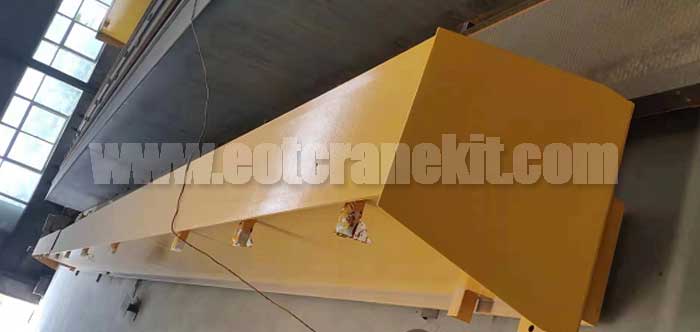
6.3 ton overhead crane kit for sale Philippines, complete single girder top running overhead crane system, low headroom design for workshop indoor use.
Free consultation to Confirm Parameters & Specifications and Get
Latest Crane Price & Crane Rate.
- Types of overhead cranes : _______?
- Optional: Overhead travelling crane, goliath gantry crane,Slewing jib crane, Single girder or double girder crane,small portable crane or kbk crane, etc.
- Capacity of overhead crane: _______?
- Optional: 0.25ton, 0.5 ton, 1 ton, 2 ton, 3ton, 5 ton, 10 ton,15ton, 20ton, 25 ton, 30ton,35ton, up to 550ton, etc.
- Crane span & lifting height : _______?
- Crane travelling length : _____?
- Control of overhead crane:_______?
- Optional: pendant/ remote/cabin control
- Voltage supply of overhead crane:_____?
- Eg,: 380V50/60HZ,3Phase or others,etc.
- Application/usage of crane:_______?
- Eg,: Steel mill, ,injection mold, cement,stone, concrete,granite, general manufacturing, etc.
Just leave a message via the contact form and our hoist and crane engineer will contact you with in 24working hours.
Get In Touch
